Deep Multi-Feature Transfer Network for Fourier Ptychographic Microscopy Imaging Reconstruction †
Abstract
:1. Introduction
2. Related Works
2.1. Imaging Model of Fourier Ptychographic Microscopic
2.2. Reconstruction Model of Fourier Ptychographic Microscopy
- Initial guess
- 2.
- Low resolution light field in computational imaging face
- 3.
- Update the amplitude of the light field
- 4.
- Spectrum of update function
- 5.
- Update all angle spectrum
- 6.
- Iteration to convergence
3. Proposed Method
3.1. Network Model Input
3.2. Reconstructed Network Structure of the Built Deep Multi-Feature Transfer Network
3.2.1. Transfer ResNet50 Base-Layer
3.2.2. Transfer Xception Base-Layer
3.2.3. Transfer DenseNet121 Base-Layer
3.2.4. Cascade Feature Fusion
3.3. Pre-Upsampling
4. Experiment
4.1. Experimental Environment
4.2. Construction of the Dataset
4.2.1. Synthesis of Simulated Experimental Data
4.2.2. Experimental Data Set Construction
4.3. Evaluation Method of Reconstruction Results
4.3.1. Evaluation Indicators of the Model
4.3.2. Reconstructed Image Evaluation Index
4.4. Experimental Results and Analysis
4.4.1. Network Model Evaluation
4.4.2. Comparison of Reconstruction Performance under Noise Conditions
4.4.3. Reconstruction Performance with Reduced Amount of Acquired Image Data
4.4.4. Reconstruction Results on the Actual Dataset
4.4.5. Reconstruction Time Comparison
5. Summary
Author Contributions
Funding
Institutional Review Board Statement
Informed Consent Statement
Data Availability Statement
Conflicts of Interest
References
- Wang, D.; Fu, T.; Bi, G.; Jin, L.; Zhang, X. Long-Distance Sub-Diffraction High-Resolution Imaging Using Sparse Sampling. Sensors 2020, 20, 3116. [Google Scholar] [CrossRef] [PubMed]
- Jiasong, S.; Yuzhen, Z.; Qian, C.; Chao, Z. Fourier Ptychographic Microscopy: Theory, Advances, and Applications. Acta Opt. Sin. 2016, 36, 1011005. [Google Scholar] [CrossRef]
- Zheng, G.; Horstmeyer, R.; Yang, C. Wide-field, high-resolution Fourier ptychographic microscopy. Nat. Photonics 2013, 7, 739–745. [Google Scholar] [CrossRef] [PubMed]
- Guoan, Z. Breakthroughs in Photonics 2013: Fourier Ptychographic Imaging. IEEE Photonics J. 2014, 6, 1–7. [Google Scholar]
- Zheng, G.; Ou, X.; Horstmeyer, R. Fourier Ptychographic Microscopy: A Gigapixel Superscope for Biomedicine. Opt. Photonics News 2014, 25, 26–33. [Google Scholar] [CrossRef]
- Xiong, C.; Youqiang, Z.; Minglu, S.; Quanquan, X. Apodized coherent transfer function constraint for partially coherent Fourier ptychographic microscopy. Opt. Express 2019, 27, 14099–14111. [Google Scholar]
- Gerchberg, R.W. A practical algorithm for the determination of phase from image and diffraction plane pictures. Optik 1972, 35, 237–250. [Google Scholar]
- Fienup, R.J. Phase retrieval algorithms: A comparison. Appl. Opt. 1982, 21, 2758–2769. [Google Scholar] [CrossRef] [Green Version]
- Ou, X.; Zheng, G.; Yang, C. Embedded pupil function recovery for Fourier ptychographic microscopy. Opt. Express 2014, 22, 4960–4972. [Google Scholar] [CrossRef]
- Bian, Z.; Dong, S.; Zheng, G. Adaptive system correction for robust Fourier ptychographic imaging. Opt. Express 2013, 21, 32400–32410. [Google Scholar] [CrossRef]
- Sun, J.; Qian, C.; Zhang, Y.; Chao, Z. Efficient positional misalignment correction method for Fourier ptychographic microscopy. Biomed. Opt. Express 2016, 7, 1336. [Google Scholar] [CrossRef] [PubMed] [Green Version]
- Zhang, J.; Xu, T.; Liu, J.; Chen, S.; Xing, W. Precise brightfield localization alignment for Fourier ptychographic microscopy. IEEE Photonics J. 2017, 10, 1109. [Google Scholar] [CrossRef]
- Tong, L.; Jufeng, Z.; Haifeng, M.; Guangmang, C.; Jinxing, H. An Efficient Fourier Ptychographic Microscopy Imaging Method Based on Angle Illumination Optimization. Laser Optoelectron. Prog. 2020, 57, 081106. [Google Scholar] [CrossRef]
- Ziqiang, L.; Xiao, M.; Jinxin, L.; Jiaqi, Y.; Shiping, L.; Jingang, Z. Fourier Ptychographic Microscopy Based on Rotating Arc-shaped Array of LEDs. Laser Optoelectron. Prog. 2018, 55, 071102. [Google Scholar] [CrossRef]
- Dong, S.; Shiradkar, R.; Nanda, P.; Zheng, G. Spectrum multiplexing and coherent-state decomposition in Fourier ptychographic imaging. Biomed. Opt. Express 2014, 5, 1757–1767. [Google Scholar] [CrossRef] [PubMed] [Green Version]
- Zhang, J.; Xu, T.; Chen, S.; Wang, X. Efficient Colorful Fourier Ptychographic Microscopy Reconstruction with Wavelet Fusion. IEEE Access 2018, 6, 31729–31739. [Google Scholar] [CrossRef]
- Bian, L.; Suo, J.; Zheng, G.; Guo, K.; Chen, F.; Dai, Q. Fourier ptychographic reconstruction using Wirtinger flow optimization. Opt. Express 2015, 23, 4856–4866. [Google Scholar] [CrossRef]
- Shaowei, J.; Kaikai, G.; Jun, L.; Guoan, Z. Solving Fourier ptychographic imaging problems via neural network modeling and TensorFlow. Biomed. Opt. Express 2018, 9, 3306. [Google Scholar]
- Zhang, Y.; Liu, Y.; Jiang, S.; Dixit, K.; Li, X. Neural network model assisted Fourier ptychography with Zernike aberration recovery and total variation constraint. J. Biomed. Opt. 2021, 26, 036502. [Google Scholar] [CrossRef]
- Lecun, Y.; Bengio, Y.; Hinton, G. Deep learning. Nature 2015, 521, 436. [Google Scholar] [CrossRef]
- Schmidhuber, J. Deep Learning in Neural Networks: An Overview. Neural Netw. 2015, 61, 85–117. [Google Scholar] [CrossRef] [PubMed] [Green Version]
- Ying, T.; Jian, Y.; Liu, X. Image Super-Resolution via Deep Recursive Residual Network. In Proceedings of the IEEE Conference on Computer Vision & Pattern Recognition, Honolulu, HI, USA, 21–26 July 2017. [Google Scholar]
- Ledig, C.; Theis, L.; Huszar, F.; Caballero, J.; Cunningham, A.; Acosta, A.; Aitken, A.; Tejani, A.; Totz, J.; Wang, Z. Photo-Realistic Single Image Super-Resolution Using a Generative Adversarial Network; IEEE Computer Society: Washington, DC, USA, 2016. [Google Scholar]
- Lim, B.; Son, S.; Kim, H.; Nah, S.; Lee, K.M. Enhanced Deep Residual Networks for Single Image Super-Resolution. In Proceedings of the 2017 IEEE Conference on Computer Vision and Pattern Recognition Workshops (CVPRW), Honolulu, HI, USA, 21–26 July 2017. [Google Scholar]
- Li, J.; Chen, Z.; Zhao, X.; Shao, L. MapGAN: An Intelligent Generation Model for Network Tile Maps. Sensors 2020, 20, 3119. [Google Scholar] [CrossRef] [PubMed]
- Rivenson, Y.; Zhang, Y.; Gunaydin, H.; Da, T.; Ozcan, A. Phase recovery and holographic image reconstruction using deep learning in neural networks. Light Sci. Appl. 2017, 7, 17141. [Google Scholar] [CrossRef] [PubMed]
- Sinha, A.T.; Lee, J.; Li, S.; Barbastathis, G. Lensless computational imaging through deep learning. Optica 2017, 4, 1117–1125. [Google Scholar] [CrossRef] [Green Version]
- Kappeler, A.; Ghosh, S.; Holloway, J.; Cossairt, O.; Katsaggelos, A. Ptychnet: CNN based fourier ptychography, 2017. In Proceedings of the IEEE International Conference on Image Processing (ICIP), Beijing, China, 17–20 September 2017. [Google Scholar]
- Nguyen, T.; Xue, Y.; Li, Y.; Tian, L.; Nehmetallah, G. Deep learning approach for Fourier ptychography microscopy. Optics Express 2018, 26, 26470. [Google Scholar] [CrossRef] [Green Version]
- Cheng, Y.F.; Strachan, M.; Weiss, Z.; Deb, M.; Carone, D.; Ganapati, V. Illumination Pattern Design with Deep Learning for Single-Shot Fourier Ptychographic Microscopy. Opt. Express 2019, 27, 644–656. [Google Scholar] [CrossRef] [Green Version]
- Yu, J.; Li, J.; Wang, X.; Zhang, J.; Liu, L.; Jin, Y. Microscopy image reconstruction method based on convolution network feature fusion. In Proceedings of the 2021 International Conference on Electronic Information Engineering and Computer Science (EIECS), Changchun, China, 23–26 September 2021. [Google Scholar]
- He, K.; Zhang, X.; Ren, S.; Sun, J. Deep Residual Learning for Image Recognition. In Proceedings of the 2016 IEEE Conference on Computer Vision and Pattern Recognition (CVPR), Las Vegas, NV, USA, 27–30 June 2016. [Google Scholar]
- Chollet, F. In Xception: Deep Learning with Depthwise Separable Convolutions. In Proceedings of the 2017 IEEE Conference on Computer Vision and Pattern Recognition (CVPR), Honolulu, HI, USA, 21–26 July 2017. [Google Scholar]
- Huang, G.; Liu, Z.; Laurens, V.; Weinberger, K.Q. Densely Connected Convolutional Networks. In Proceedings of the Conference on Computer Vision and Pattern Recognition, Honolulu, HI, USA, 21–26 July 2017. [Google Scholar]
- Zhang, J.; Xu, T.; Shen, Z.; Qiao, Y.; Zhang, Y. Fourier ptychographic microscopy reconstruction with multiscale deep residual network. Opt. Express 2019, 27, 8612–8625. [Google Scholar] [CrossRef]
- Zhao, X.D.; Huang, H. Research on face recognition based on convolutional neural network. Inf. Technol. 2018, 10, 920. [Google Scholar]
- Wang, Z.; Chen, J.; Hoi, S.C.H. Deep Learning for Image Super-resolution: A Survey. IEEE Trans. Pattern Anal. Mach. Intell. 2020, 43, 3365–3387. [Google Scholar] [CrossRef] [Green Version]
- Yang, W.; Zhang, X.; Tian, Y.; Wang, W.; Xue, J.H. Deep Learning for Single Image Super-Resolution: A Brief Review. IEEE Trans. Multimedia 2019, 21, 3106–3121. [Google Scholar] [CrossRef] [Green Version]
- Chao, Z.; Sun, J.; Qian, C. Adaptive step-size strategy for noise-robust Fourier ptychographic microscopy. Opt. Express 2016, 24, 20724–20744. [Google Scholar]
- Wang, Z. Image Quality Assessment: From Error Visibility to Structural Similarity. IEEE Trans. Image Processing 2004, 13, 600–612. [Google Scholar] [CrossRef] [PubMed] [Green Version]







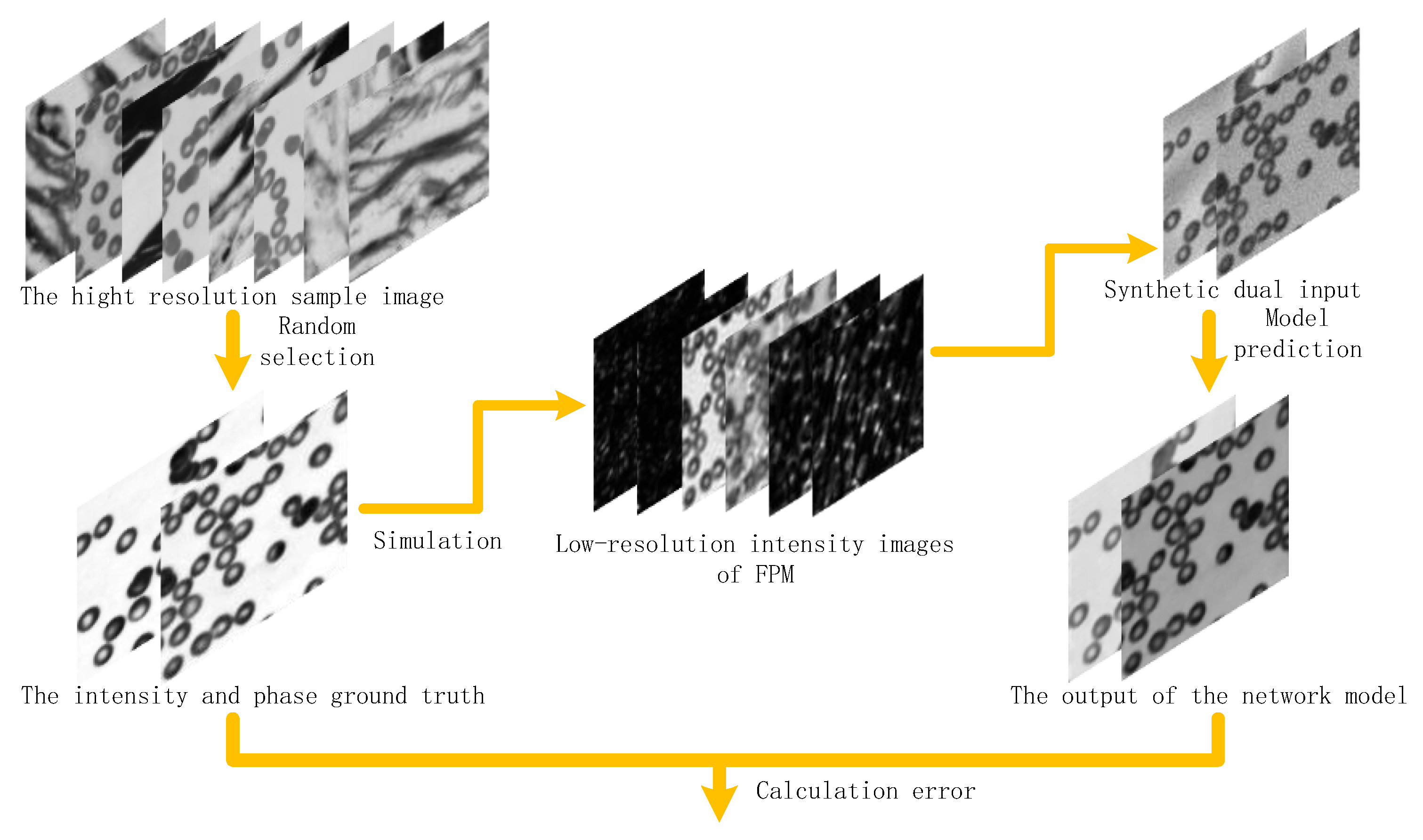
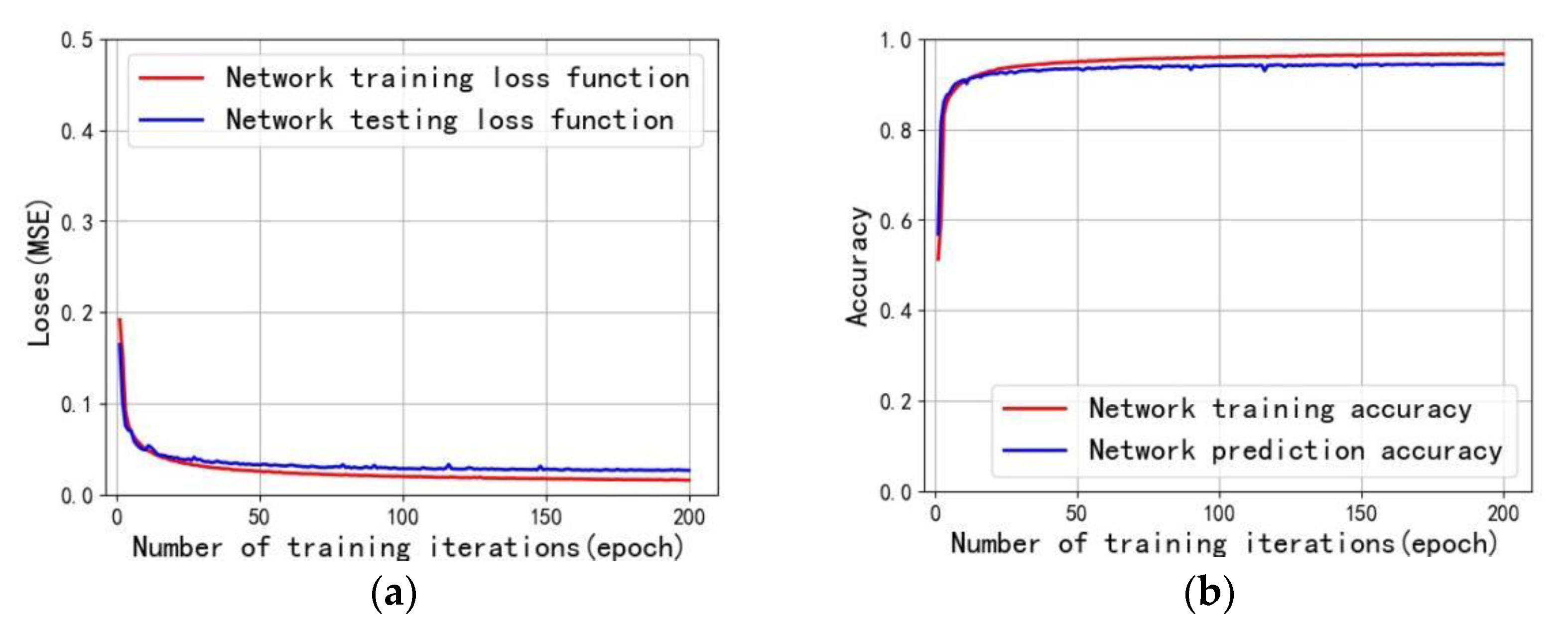
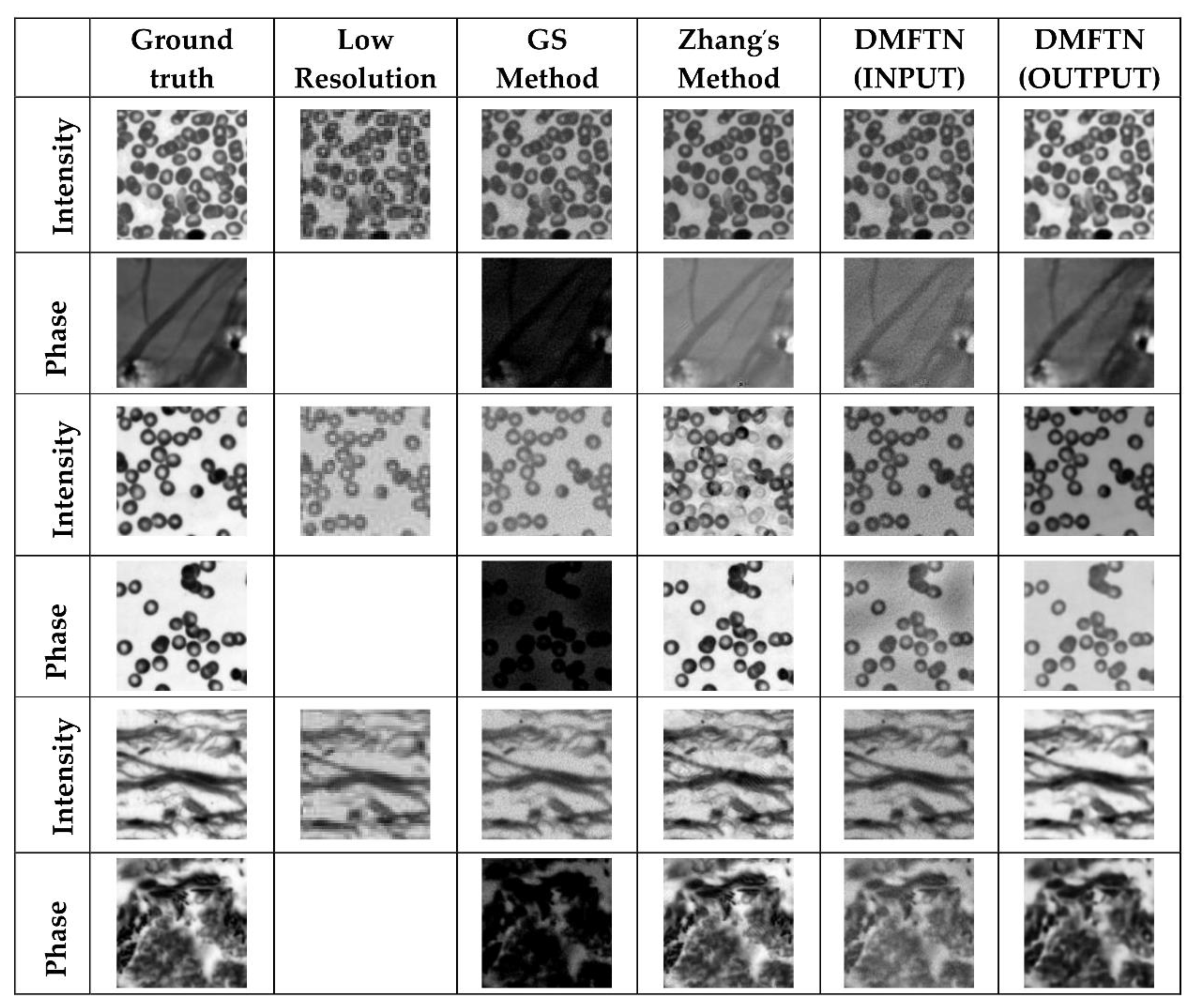
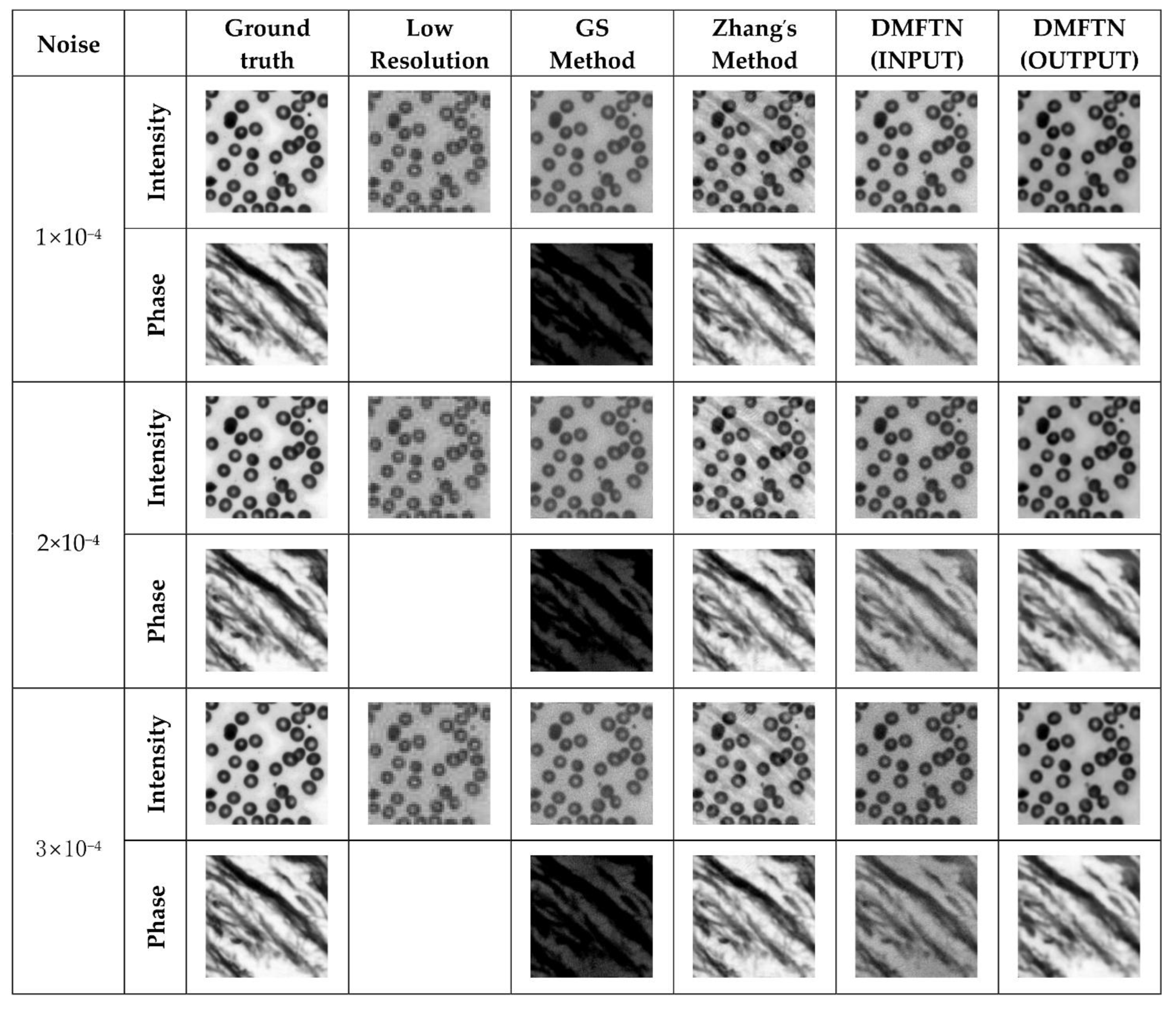
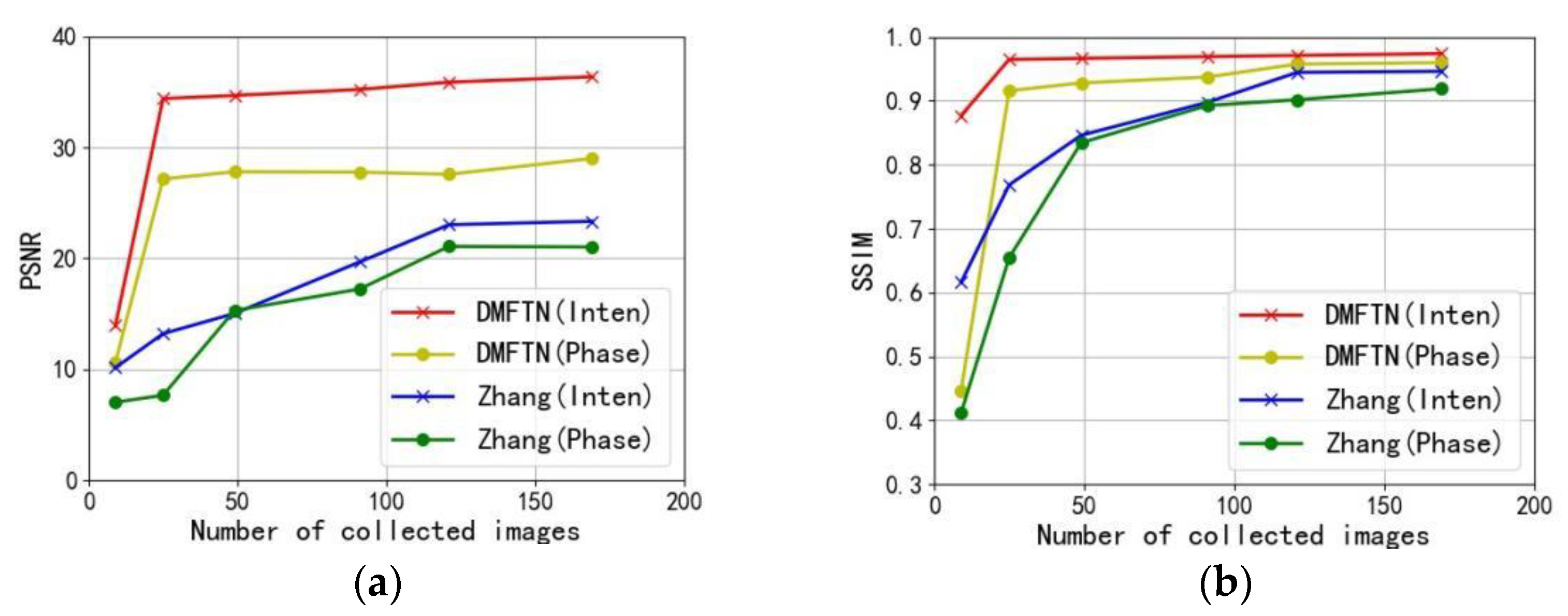
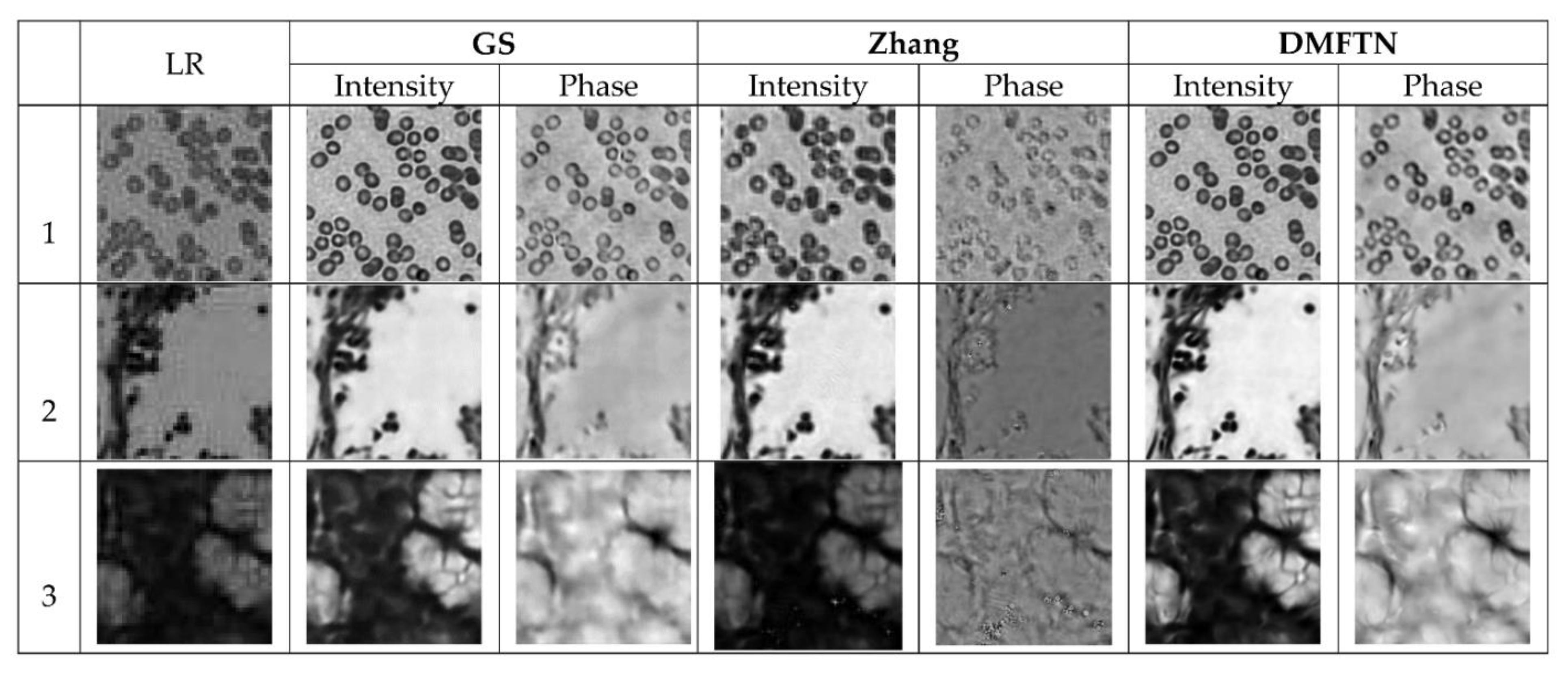
| Low Resolution (PSNR/SSIM) | G-S H-Method (PSNR/SSIM) | Zhang’s Method (PSNR/SSIM) | DMFTN (INPUT) (PSNR/SSIM) | DMFTN (OUTPUT) (PSNR/SSIM) | ||
|---|---|---|---|---|---|---|
| Group 1 Images | Intensity | 21.25/0.723 | 24.02/0.761 | 26.27/0.922 | 23.91/0.771 | 34.79/0.979 |
| Phase | 13.93/0.278 | 22.52/0.786 | 12.12/0.083 | 25.99/0.965 | ||
| Group 2 Images | Intensity | 24.76/0.844 | 22.62/0.592 | 20.03/0.787 | 23.13/0.613 | 35.73/0.981 |
| Phase | 4.29/0.229 | 16.01/0.877 | 3.51/0.016 | 33.43/0.976 | ||
| Group 3 Images | Intensity | 24.77/0.840 | 28.94/0.554 | 22.77/0.920 | 23.66/0.678 | 36.54/0.979 |
| Phase | 10.93/0.264 | 21.52/0.932 | 9.19/0.015 | 24.84/0.932 | ||
| Same IMAGE | Noise Level | Low Resolution (PSNR/SSIM) | I-S Method (PSNR/SSIM) | Zhang’s Method (PSNR/SSIM) | DMFTN (INPUT) (PSNR/SSIM) | DMFTN (OUTPUT) (PSNR/SSIM) | |
|---|---|---|---|---|---|---|---|
| Group 1 Images | Intensity | 24.42/0.827 | 28.85/0.848 | 30.38/0.861 | 28.76/0.937 | 35.12/0.981 | |
| Phase | 7.97/0.223 | 26.11/0.928 | 5.99/0.021 | 26.63/0.45 | |||
| Group 2 Images | Intensity | 22.24/0.718 | 25.12/0.722 | 27.62/0.836 | 25.77/0.737 | 34.99/0.979 | |
| Phase | 7.43/0.205 | 25.72/0.923 | 6.17/0.118 | 26.35/0.944 | |||
| Group 3 Images | Intensity | 20.11/0.622 | 23.26/0.643 | 21.47/0.861 | 23.91/0.662 | 34.79/0.979 | |
| Phase | 7.27/0.197 | 18.78/0.92 | 5.96/0.013 | 26.08/0.952 | |||
| Reconstruction Method | Number of Iterations | Reconstruction Time | Multiple |
|---|---|---|---|
| G-S Method | 50 | 1.684 s | 17 |
| AS Method | 50 | 1.977 s | 22 |
| Zhang’s Method | 20 | 204.5 s | 48,822 |
| Method of this article (DMFTN) | 0 | 0.091 s | 1 |
Publisher’s Note: MDPI stays neutral with regard to jurisdictional claims in published maps and institutional affiliations. |
© 2022 by the authors. Licensee MDPI, Basel, Switzerland. This article is an open access article distributed under the terms and conditions of the Creative Commons Attribution (CC BY) license (https://creativecommons.org/licenses/by/4.0/).
Share and Cite
Wang, X.; Piao, Y.; Yu, J.; Li, J.; Sun, H.; Jin, Y.; Liu, L.; Xu, T. Deep Multi-Feature Transfer Network for Fourier Ptychographic Microscopy Imaging Reconstruction. Sensors 2022, 22, 1237. https://doi.org/10.3390/s22031237
Wang X, Piao Y, Yu J, Li J, Sun H, Jin Y, Liu L, Xu T. Deep Multi-Feature Transfer Network for Fourier Ptychographic Microscopy Imaging Reconstruction. Sensors. 2022; 22(3):1237. https://doi.org/10.3390/s22031237
Chicago/Turabian StyleWang, Xiaoli, Yan Piao, Jinyang Yu, Jie Li, Haixin Sun, Yuanshang Jin, Limin Liu, and Tingfa Xu. 2022. "Deep Multi-Feature Transfer Network for Fourier Ptychographic Microscopy Imaging Reconstruction" Sensors 22, no. 3: 1237. https://doi.org/10.3390/s22031237
APA StyleWang, X., Piao, Y., Yu, J., Li, J., Sun, H., Jin, Y., Liu, L., & Xu, T. (2022). Deep Multi-Feature Transfer Network for Fourier Ptychographic Microscopy Imaging Reconstruction. Sensors, 22(3), 1237. https://doi.org/10.3390/s22031237





